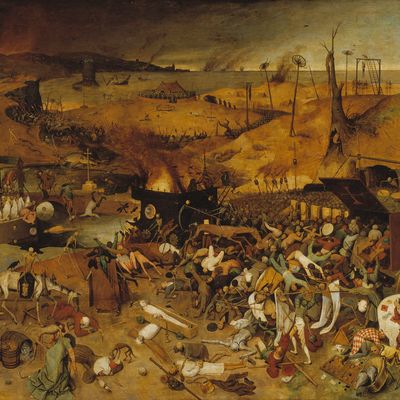
Usually, summer swings in and everything just gets impossibly fun (eating alfresco, late nights, officewide summer Fridays, overcrowded beaches, pollen, upper-lip sweat — it’s wonderful, all of it), so it’s okay to wonder what was seriously up with 2014’s summer terribilis. ISIS and the return of beheadings, Israel and Hamas fighting, Russia’s soft invasion of the Ukraine, police brutality, three planeloads of people dead in a week, Robin Williams, Ebola … there was gloom every time you checked the news. But on the bright side, humanity has endured some even more miserable summers. Here are seven that, according to historians (and with an admitted focus on the Western world), would’ve made your Facebook and Twitter feeds even bleaker.
1348
This particular summer in Europe made our current one “seem like a walk in the park,” says Stephen Greenblatt, author of The Swerve: How the World Became Modern. Bubonic plague showed up from the East, killing more than 60 percent of the population in certain places. Just as bad, Greenblatt says, was the “almost complete breakdown of the social order. The dead and dying were abandoned in the streets; friends fled from friends; even some parents refused to attend their dying children.” The eternal optimist can point out this actually led to higher wages, he concedes, but only because “there were not enough working men and women who had survived.”
1709
Winter had been the pits already — Europe’s worst in half a millennium, frigid enough that Venetians were walking across the Adriatic lagoon — but it was summer when agriculture ground to a halt. Derek Wilson writes in Calamities & Catastrophes: The Ten Absolutely Worst Years in History that there was famine, rioters filled the now-temperate streets, profiteers hoarded all of the grain, and mass deforestation began in the Caribbean. People fled their land, particularly poor Germans, who by summer made it to London, where they met locals “astonished to find the streets of that metropolis swarming with men and women of an alien race.” They shipped the newcomers to America, but many died en route. One group had it worse, though: Swedish troops suffered till June, then died fighting Peter I in the battle that established Russia as a world power.
1877
The last summer of Reconstruction, says Columbia historian Eric Foner, was “particularly bad” thanks to several factors: For one, the federal government sent troops to break a national strike that froze the nation’s railroads, but it yanked them out of the South, which amounted to “abandon[ing] its commitment to protect the basic rights of the former slaves.” That summer also, Foner argues, set a horrible precedent in which “the rights of corporations trumped those of labor,” and “the constitutional guarantees of the rights of African-Americans were violated.”
1918
Flu normally is worse in the winter, but the Spanish influenza pandemic that probably killed 5 percent of Earth’s population and infected up to one third disturbingly hit its stride in the summer and early fall. Josh Barry, who wrote The Great Influenza: The Story of the Deadliest Pandemic in History, says it’s possible that during this period — still very much wartime, let’s not forget — a summertime wave of this mutated super-virus killed more people than AIDS has killed to date.
1968
It was the “year that changed everything” — or at least that “changed the world” — so of course the three hottest months represent “one of the most difficult summers in history,” says Tufts historian Peniel Joseph. Within months of Martin Luther King Jr. dying, riots overtook Detroit and Boston, and Robert Kennedy was assassinated. Richard Nixon, meanwhile, was prevailing in the polls against Hubert Humphrey and George Wallace, the other two legs of “arguably the worst trio to ever run for president.” As another historian, the University of Virginia’s Brian Balogh, points out, “more than 16,000 Americans troops” were killed in Vietnam that year and hundreds of protesters were clubbed by Chicago police during the Democratic Party’s convention in August.
1979
This tinderbox of a summer began with Three Mile Island already in meltdown, America’s worst nuclear disaster, then erupted into a full-on energy crisis when the Iranian revolution caused a summerlong gas shortage. The period marked what the historian Robert Tucker called an exclamation point on “the continued terrible decline in the nation’s international position”: Ba’athist strongman Saddam Hussein became Iraq’s president; America inserted itself into El Salvador’s civil war; the Soviet-friendly Sandinistas assumed power in Nicaragua shortly after an ABC News correspondent was murdered there, with the killing shown on the nightly news. In the end, a May with America’s deadliest plane crash gave way to a September with Hurricane Frederic, then the costliest in U.S. history.
1994
This summer played out like 2014’s more evil twin. It had awful mass-transit tragedies: USAir Flight 427 crashed in Pittsburgh, killing 132 people on board; the MS Estonia took 852 passengers to the bottom of the Baltic. A deadly heatwave blanketed the U.S. The plague ravaged India. Then there was the summerlong page-one fight between what journalist Walter Goodman deplored as “the mass media’s thralldom to ratings” (the O.J. Simpson trial) and “scenes of horror that cannot be equaled” (Rwanda’s genocide, annihilation of nearly a fifth of the entire population).





























